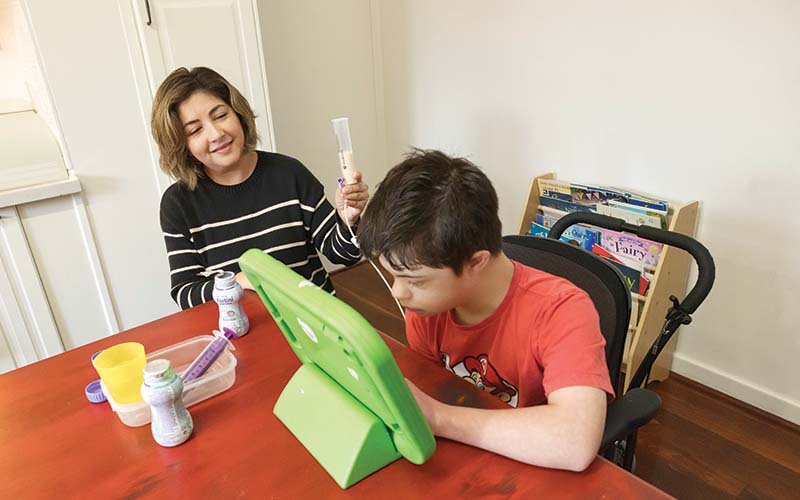Eating the food we need to stay healthy and strong is a straightforward, everyday act for most members of the population.
But for thousands of children around Australia with intellectual and other disabilities, the process of eating can be traumatic, posing challenges that veer from uncomfortable to life threatening.
Trouble chewing and swallowing and nasal or gastro-oesophageal reflux are common in children with severe disability – often leading to poor growth and a higher risk both of aspiration of food and liquid into the lungs, and recurring chest infections.
“Mealtimes for these families can be distressing – not only for the child, but for parents who can see their child isn’t getting the nutrition or medication they need,” said The Kids Research Institute Australia Child Disability Head, Associate Professor Jenny Downs.
Families in this situation may opt for a gastrostomy, a reversible surgical procedure which allows for a feeding tube to be placed directly into the child’s stomach.
Even though our research has shown many benefits from gastrostomy, both for children’s physical and mental health, it can be difficult for parents to make the decision.
Those who do choose gastrostomy may feel concern over the procedure itself, how they will learn the skills needed to manage feeds, and what it will mean for their child’s ability to live a full life.
Now, a first-of-its-kind online resource called Nourish – developed by The Kids with families, Developmental Disability WA (DDWA), and Perth Children’s Hospital (PCH) clinicians and gastrostomy nurses – is not only helping parents through the decision process, but easing the transition for those who go ahead.
Launched in September 2022 and hosted on DDWA’s website, Nourish provides information tailored to families and carers in the form of videos and ‘Ask and Do’ exercises. Parents feature in many of the videos, discussing why they chose gastrostomy, the life-changing difference it has made, and tips and tricks they’ve learned.
The resources have been shared with schools, care facilities, and clinical specialist nurses in other fields, and are now automatically provided to families following in-person and telehealth gastrostomy consultations at PCH.
Associate Professor Downs said the feedback had been overwhelmingly positive, particularly among parents and organisations supporting families living with disability.

Pictured: Natalie Hevron feeds son Samuel, who had a gastrostomy inserted in 2019
Life-changing decision helping Samuel to thrive
For Perth mum-of-three Natalie Hevron, the word ‘gastrostomy’ is interchangeable with ‘godsend’.
She and husband Matthew decided to try the procedure for their eldest son, Samuel, who was born with Down syndrome, to counter persistent feeding problems that were hampering his ability to take in enough nutrition to grow and thrive.
Now 13, throughout his short life Samuel has endured countless hospitalisations – including for open heart surgery at five months of age and leukaemia at 18 months. “Samuel has quite a complex mix of issues which, put together, make it harder for him to swallow,” Natalie said.
“He was getting a lot of nasal regurgitation and could only manage soft purees and foods like yoghurt. The more he ate, the more it would go up his nose and the more he would sneeze it out. It was awful and uncomfortable for him, and he was getting sinus infections.”
Samuel underwent his gastrostomy in 2019, and while navigating the new feeding process was initially difficult, the results have spoken for themselves.
“For one thing I no longer had to make such a massive quantity of blended food and try to have Sammy eat it. But more importantly he started putting on weight and his development increased dramatically,” Natalie said.
It was quite amazing watching that change and how much he actually needed that – since then he’s just gone up and up.
Natalie shared her family’s experiences with Associate Professor Downs and team to help them develop Nourish, a set of resources designed to support families and health and allied professionals on the gastrostomy journey.
“Nourish didn’t exist when we first contemplated a gastrostomy and we had to figure a lot out through trial and error, and speaking to different parents to try to gather the information we needed,” she said.
“Simple things like how do you order the feeds and equipment, how do you store and wash your equipment, and can you use it again?
“There are so many practical things that have an impact if not dealt with – little things can turn into big things. Having practical solutions can provide a sense of control around a not-so-controllable situation.”
Did you know
- More than 5,000 children born each year in Australia will grow up with intellectual disability
- Children with severe disability often have eating difficulties that stop them getting enough calories or medication
- Gastrostomy is a procedure which allows for a feeding tube to be placed directly into the stomach
- More than 300 WA children and around 3,000 children across Australia live with a gastrostomy
- Since being launched in 2022 the Nourish videos have been viewed more than 1,000 times
- Find the Nourish resources at ddwa.org.au.
